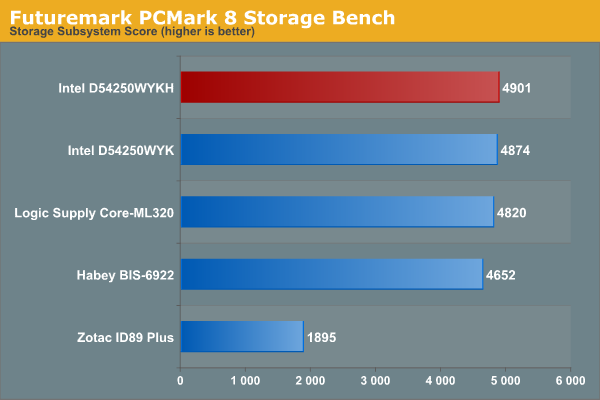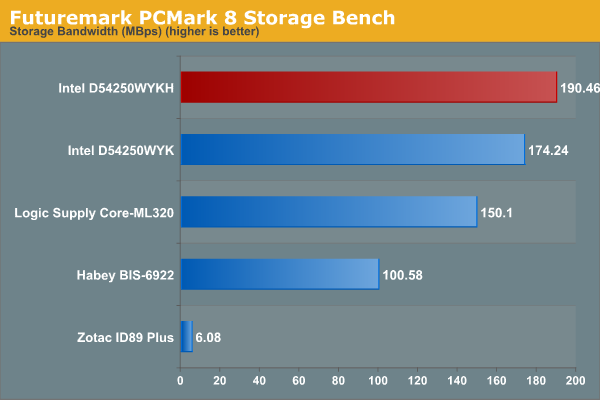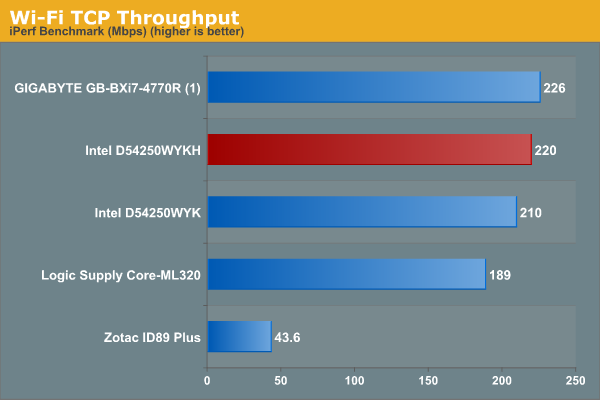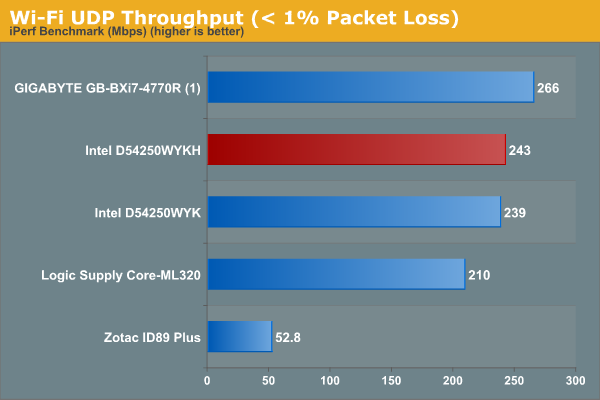Intel D54250WYKH Haswell NUC Kit with 2.5" Drive Slot Mini-Review
by Ganesh T S on May 18, 2014 10:15 AM ESTStorage & Wireless Networking Credentials
We have recently started devoting a separate section to analyze the storage and networking credentials of the units under review. On the storage side, one option would be repetition of our strenuous SSD review tests on the drive(s) in the PC. Fortunately, to avoid that overkill, PCMark 8 has a storage bench where certain common workloads such as loading games and document processing are replayed on the target drive. Results are presented in two forms, one being a benchmark number and the other, a bandwidth figure. We ran the PCMark 8 storage bench on selected PCs and the results are presented below.


On the networking side, we restricted ourselves to the evaluation of the WLAN component. Our standard test router is the Netgear R7000 Nighthawk configured with both 2.4 GHz and 5 GHz networks. The router is placed approximately 20 ft. away, separated by a drywall (as in a typical US building). A wired client (Zotac ID89-Plus) is connected to the R7000 and serves as one endpoint for iPerf evaluation. The PC under test is made to connect to either the 5 GHz (preferred) or 2.4 GHz SSID and iPerf tests are conducted for both TCP and UDP transfers. It is ensured that the PC under test is the only wireless client for the Netgear R7000. We evaluate total throughput for up to 32 simultaneous TCP connections using iPerf and present the highest number in the graph below.

In the UDP case, we try to transfer data at the highest rate possible for which we get less than 1% packet loss.











36 Comments
View All Comments
AgeOfPanic - Monday, May 19, 2014 - link
I use a Haswell core i3 version of the Gigabyte Brix with a OCZ Vertex SSD and I really like the system. Great form factor and mounting it behind the monitor makes for a very clean system. I don't think I'll go back to a different form factor for normal desktop systems again.To reply to the issue with the Intel AC760. I replaced the standard wifi card in the Brix for a Intel AC760 version. I use the standard drivers from Windows 8.1. I cannot reliably connect to the 5 GHz network of my Asus AC66u router. It works OK on the 2.4 GHz band, but I'm a little disappointed in this. Seems the drivers definitely need to mature.
Laststop311 - Monday, May 19, 2014 - link
This nuc is only good if u want to turn your dumb tv into a smart tv that's smarter than all tv's with built in smart functionalities. Gaming on ULV graphics = boooooooo. If you want to game in this tiny form factor you should get an amd apu. 5000 blowsdblagent - Monday, May 19, 2014 - link
Quick question that I assume I already know the answer to, these will support dual video output correct? I assume they will, and if so then I could see moving my entire office over to these in the future. I just built 40 desktops and building these would be a world easier.They all have Samsung SSDs so this new 2.5 form factor support will be a savior, though I'm set for several years now. Maybe as I get some more users I will build these over my custom built solution. Would save me some grey hair!
ptmmac - Monday, May 19, 2014 - link
Am I the only person who would like to see a single slot Pci for the 750 ti from nvidia in something this size?. I realize it would increase the power envelope, but it would also make gaming practical. AMD is supposedly working on a competitor for the 750 ti and this would give the purchaser a better set of options.run - Monday, May 19, 2014 - link
The hard disk is where the operating system and all software applications are stored. Because of this, a properly working drive is essential in the operation of any computer or laptop.CSMR - Tuesday, May 20, 2014 - link
Questions:1. How well damped is the 2.5" hard drive cage? I think this is mainly for regular HDDs (since you get mSATA for SDDs) so I am interested in how noisy HDDs are in this case.
2. The TrueCrypt benchmark doesn't look so good. Does this suggest that with native Windows whole-drive encryption, that encryption will limit read/write speed? I would have expected with AES-NI to get hardware encryption and decryption at closer to the SATA limit of 6Gbps.
darckhart - Tuesday, May 20, 2014 - link
ganesh, have you tried installing windows 8 via uefi msata gpt on this intel nuc? i updated the nuc bios to 25, but the msata (crucial m550 256gb) is still undetectable via uefi. shows up just fine in legacy bios. wondering if this is a nuc issue.prophet001 - Wednesday, May 21, 2014 - link
It was a mission to find out what NUC stood for. Might want to include that in the future.:)
kaymack - Wednesday, May 21, 2014 - link
This article seems to imply that the D54250WYKH model has only the 2.5" drive bay available for storage and no MSATA slot. Based on info I've seen elsewhere, I was under the impression that the D54250WYKH model will accept an MSATA drive on the board AND a 2.5" drive in the bay...so one could have say a Crucial M550 MSATA as the boot drive for OS and programs and also contain a 2.5" HDD or SSD for additional storage of data, music, video, etc. Can anyone confirm this?Jas448 - Saturday, May 31, 2014 - link
I have installed windows 8.1 to a Crucial 240 M500 msata and using a sanDisk SSD250Gb as a 2nd drive in the 2.5 inch bay. No problems at all. The only problem I had was Windows would not install from a USB3 flashdrive but would from a USB2 Flashdrive